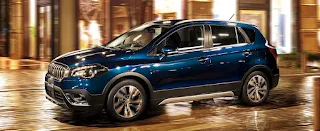 |
| 2019 Suzuki Spacia Gear |
 |
| 2019 Suzuki Spacia Gear |
The third Spacia variant, the Spacia Gear, is targeted for the adventurous people who like to have a laid-back lifestyle on the great outdoors. Judging by the design, it looks like a mash-up between the normal Spacia and the current Jimny but for some reasons, the Spacia Gear almost copied the looks of the Daihatsu Wake, one of the key opponents of the Spacia Gear. Whatever their reason, the SUV-inspired kei minivan made for the laid-back campers doesn't look that bad and once you step inside...
 |
| 2019 Suzuki Spacia Gear interior |
The Spacia Gear's interior still feels the same as the normal Spacia. The room's tall, it still seats up to five, can be arranged for whatever you want to do with it, decent room in the back for your picnic snacks, so on, so forth. However, since this is the Gear, what you will notice that the instrumental panel reminded us of the X-BEE while the glove compartment design has some jerry can design into it, reflecting its laid-back camp attitude. Oh, the seats do come with waterproof fabric and here's your plus one for you, boy scout.
 |
| 2019 Suzuki Spacia Gear |
Running on a lighter and more rigid HEARTECT platform, the Spacia Gear is powered by Suzuki's Mild Hybrid technology featuring an Integrated Starter Generator linked to a li-ion battery pack collaborating with its fuel-efficient 660cc engine. In its natural aspiration form and CVT gearbox, fuel economy is around 28.2km/L on JC08 mode standards for front-wheel drive variants while turbo variants can do up to 25.6km/L.
The Gear comes with the latest version of SUZUKI SAFETY SUPPORT, which is a suite of safety features such as Lane Departure Warning function, wandering alarm function, high beam assist, sign recognition function provided by its optional omni-directional monitor camera package, advance car departure notice function, dual sensor brake support, false start suppression, brake support, backward error start suppression, and more, making the journey home more safe and secure for everyone and such tech gave the Spacia range an ASV++ grade by the JNCAP.
The Spacia Gear starts at 1,614,600 Japanese Yen (less than 800,000 pesos) so if you laid-back campers have that amount of cash, you can buy this not-so-rugged but laid-back Spacia fit for your laid-back lifestyle in the great outdoors.
Photo: Suzuki Motor Corporation
The Spacia Gear starts at 1,614,600 Japanese Yen (less than 800,000 pesos) so if you laid-back campers have that amount of cash, you can buy this not-so-rugged but laid-back Spacia fit for your laid-back lifestyle in the great outdoors.
Photo: Suzuki Motor Corporation














































